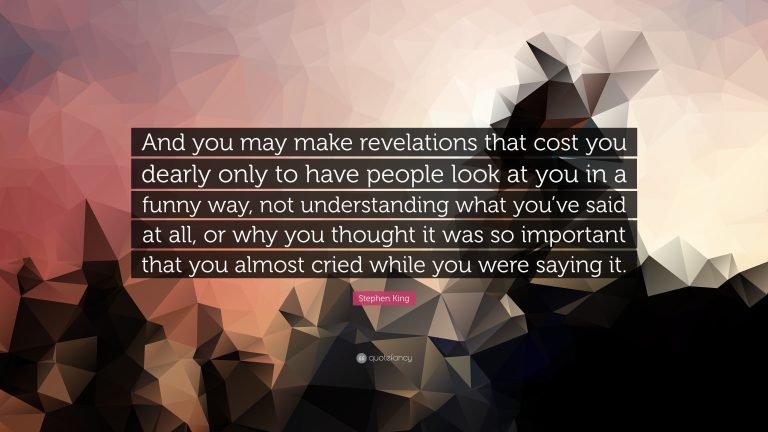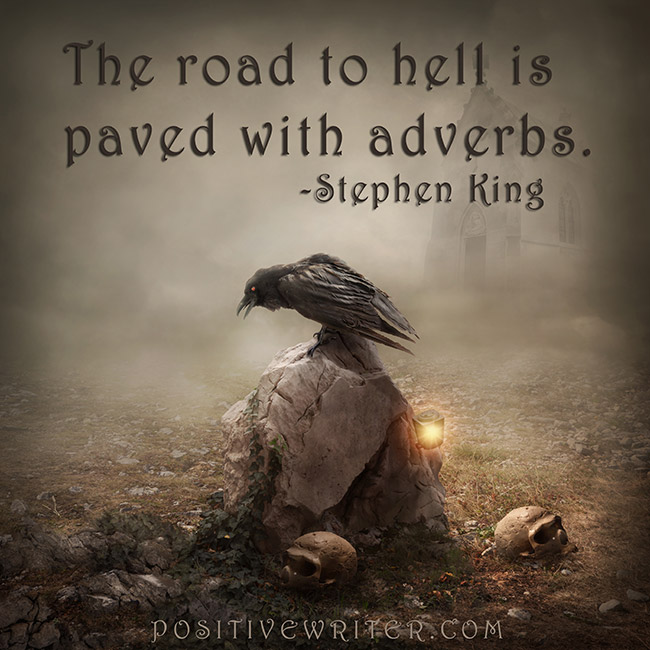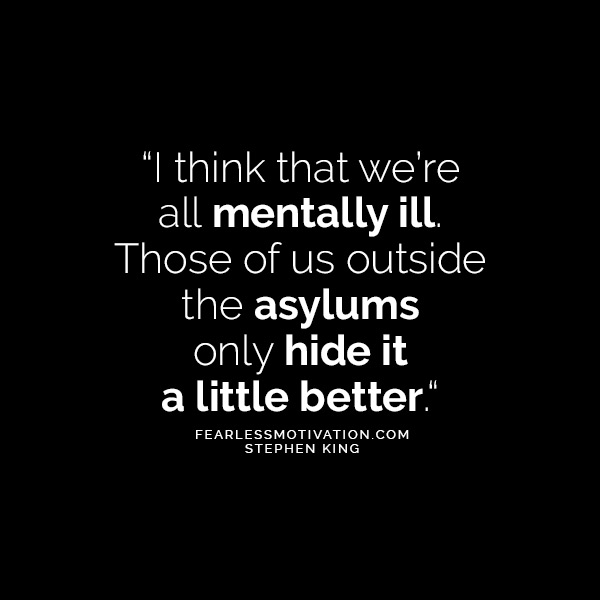Stephen King Quotes: The Power Of Symbolism In Horror
Stephen King, the master of horror, has captivated readers for decades with his spine-chilling tales. But what sets his work apart from other horror writers? It’s the power of symbolism. In this article, we will delve into the world of Stephen King quotes and explore how he uses symbolism to create a truly terrifying and thought-provoking experience.
When it comes to horror, it’s not just about the scares; it’s about the deeper meaning behind the fright. Stephen King understands this better than anyone. His quotes are filled with layers of symbolism that add depth and complexity to his stories. Whether it’s the haunted hotel in “The Shining” representing the dark corners of the human mind or the demonic clown in “It” symbolizing childhood fears, King’s use of symbolism elevates his horror to a whole new level.
So, join me as we explore the twisted and brilliant mind of Stephen King, unraveling the hidden meanings behind his quotes and discovering the power of symbolism in horror. Get ready to be both terrified and enlightened as we dive into the dark and captivating world of Stephen King’s imagination.

Stephen King Quotes: The Power of Symbolism in Horror
Stephen King, a master of the horror genre, is known for his chilling tales and captivating storytelling. But beyond the scares and thrills, King’s works are rich with symbolism that adds depth and meaning to his narratives. In this article, we will explore the power of symbolism in horror through the lens of Stephen King’s quotes. From the eerie Pennywise in “It” to the haunted overlook hotel in “The Shining,” King’s use of symbolism enhances the reader’s experience and leaves a lasting impression.
The Symbolism of Monsters
In many of Stephen King’s novels, monsters serve as powerful symbols that represent our deepest fears and anxieties. They embody the darkness within ourselves and society. Take Pennywise, the terrifying clown from “It,” for example. On the surface, Pennywise is a monstrous entity that preys on children, but he also represents the hidden terrors and traumas that haunt the town of Derry. Through this symbolism, King explores the lasting impact of childhood trauma and the importance of facing our fears.
Another example is the iconic vampire in “Salem’s Lot.” The vampire symbolizes the corruption and decay that can infect a community, turning its inhabitants into soulless creatures. King uses this symbolism to delve into themes of addiction, societal decay, and the erosion of humanity. By personifying these abstract concepts, King creates a visceral and thought-provoking reading experience.
The Haunted Places: Symbolism of the Setting
In Stephen King’s novels, the settings themselves often take on symbolic significance. The haunted overlook hotel in “The Shining” is a prime example. The hotel represents the dark history and suppressed evil that lingers within its walls. It becomes a character of its own, driving the characters to madness and violence. Through this symbolism, King explores the destructive power of isolation, addiction, and the overwhelming weight of the past.
Similarly, in “Pet Sematary,” the burial ground behind the Creeds’ house symbolizes the human desire to defy death and the consequences that come with tampering with the natural order. The burial ground becomes a metaphor for the characters’ grief and their inability to let go of their loved ones. King uses this symbolism to explore the complexities of grief, loss, and the lengths people will go to avoid accepting death.
King’s use of symbolism in the settings of his novels adds layers of meaning and enhances the atmosphere of horror. By infusing his locations with symbolism, he creates a sense of unease and tension that lingers with the reader long after they finish the book.
Symbolism and Character Development
In addition to monsters and settings, Stephen King’s use of symbolism extends to his characters, providing insight into their motivations and inner struggles. One notable example is Carrie White from “Carrie.” Carrie represents the outsider, the repressed and misunderstood individual who finally unleashes her hidden power. Through her character, King explores themes of bullying, social alienation, and the destructive consequences of suppressing one’s true self.
Another example is Jack Torrance from “The Shining.” Jack symbolizes the descent into madness and the destructive nature of unchecked anger and resentment. As his sanity unravels, the character becomes a vessel for the malevolent forces that reside within the overlook hotel. King uses this symbolism to examine the corrosive effects of toxic masculinity and the consequences of unresolved personal demons.
The Power of Symbolic Objects
Symbolic objects play a significant role in Stephen King’s works, adding depth and meaning to the narrative. One such object is the red balloon in “It.” The balloon represents the presence of Pennywise and serves as a haunting reminder of the town’s dark secrets. Its appearance throughout the story creates a sense of foreboding and impending danger.
In “The Dark Tower” series, the gunslinger’s guns symbolize his code of honor and the weight of his mission. These guns become extensions of his identity and a physical representation of his dedication to his quest. By imbuing these objects with symbolic meaning, King enhances the emotional impact of the story and invites readers to reflect on the deeper themes and messages.
In conclusion, Stephen King’s quotes demonstrate the power of symbolism in horror literature. Through monsters, settings, characters, and objects, King infuses his stories with layers of meaning that resonate with readers on a profound level. By delving into the hidden depths of human experience, King invites us to confront our fears, examine our motivations, and explore the darker corners of our own psyches. His use of symbolism elevates his works from mere horror tales to thought-provoking reflections on the human condition.
Key Takeaways: Stephen King Quotes – The Power of Symbolism in Horror
- Symbolism adds layers of meaning to horror stories, making them more complex and thought-provoking.
- Stephen King often uses symbols like animals, objects, and locations to represent deeper themes and emotions.
- Symbolism helps create a sense of unease and suspense in horror literature.
- King’s use of symbolism allows readers to connect with the story on a deeper level and explore their own fears and anxieties.
- The power of symbolism in horror lies in its ability to tap into universal fears and evoke strong emotions in readers.
Frequently Asked Questions
How does Stephen King use symbolism in his horror novels?
In his horror novels, Stephen King is known for his masterful use of symbolism to create a deeper and more impactful reading experience. He often uses symbols to represent abstract concepts, fears, or hidden meanings that add layers of complexity to his stories. By using symbolism, King is able to tap into the reader’s subconscious and evoke a sense of unease, making the horror more psychological and thought-provoking.
For example, in his novel “It”, the clown Pennywise is a symbol of childhood fears and the loss of innocence. Through this symbol, King explores themes of trauma and the lasting impact it can have on individuals. By using symbolism, King is able to address deeper societal and psychological issues, elevating his horror novels beyond mere scares.
Why is symbolism important in horror literature?
Symbolism plays a crucial role in horror literature as it adds depth and richness to the narrative. It allows authors to convey complex ideas, emotions, and themes in a more subtle and nuanced way. In horror, symbolism can be used to tap into the reader’s subconscious and evoke a sense of unease, making the fear more psychological and lingering.
Furthermore, symbolism can also provide a deeper understanding of the human condition and explore universal themes such as fear, death, and the dark side of humanity. It adds layers of meaning to the story, allowing readers to interpret and analyze the text on multiple levels. Symbolism in horror literature is a powerful tool that enhances the reading experience and elevates the genre.
What are some notable examples of symbolism in Stephen King’s horror novels?
Stephen King is known for his masterful use of symbolism in his horror novels. One notable example is the Overlook Hotel in “The Shining”. The hotel itself serves as a symbol of the protagonist’s descent into madness and the dark forces that lurk within. It represents the isolation, claustrophobia, and psychological torment that the characters experience.
Another example is the red balloon in “It”, which symbolizes the lurking evil and the presence of Pennywise the clown. The balloon serves as a recurring motif throughout the story, appearing in moments of danger and impending doom. It represents the fear and uncertainty that the characters face, as well as their collective childhood traumas.
How does symbolism enhance the horror reading experience?
Symbolism enhances the horror reading experience by adding layers of meaning and complexity to the narrative. It allows readers to delve deeper into the story and uncover hidden themes and messages. Symbolism evokes a sense of unease and taps into the reader’s subconscious, making the fear more psychological and lingering.
By using symbols, authors can explore deeper human emotions, fears, and desires. It invites readers to interpret and analyze the text, creating a more engaging and thought-provoking reading experience. Symbolism in horror literature also provides a sense of unity and coherence to the story, as recurring symbols tie different elements together and create a cohesive narrative.
How does Stephen King’s use of symbolism impact the horror genre?
Stephen King’s use of symbolism has had a profound impact on the horror genre. His masterful incorporation of symbols elevates his novels beyond mere scares, making them thought-provoking and intellectually stimulating. By addressing deeper societal and psychological issues through symbolism, King pushes the boundaries of the genre and expands its possibilities.
Furthermore, King’s use of symbolism in horror literature has inspired countless authors to explore the power of symbols in their own works. It has become a hallmark of the genre and a way for authors to create more immersive and impactful reading experiences. King’s influence on the use of symbolism in horror cannot be overstated, as it has become an integral part of the genre’s storytelling.
Stephen King Reveals His Top Five Stephen King Stories
Final Summary: The Power of Symbolism in Horror
Now that we’ve delved into the captivating world of Stephen King quotes and explored the power of symbolism in horror, it’s clear that King is a master of his craft. His ability to weave intricate layers of meaning into his stories is truly remarkable. Through the use of symbols, he invites readers to engage in a deeper level of analysis and interpretation, making the reading experience all the more enriching.
King’s understanding of the human psyche and his knack for creating relatable characters allow him to tap into our deepest fears and desires. By employing symbolism, he adds an extra layer of complexity to his narratives, highlighting the universal themes that resonate with readers on a profound level. Whether it’s a menacing clown hiding something sinister or a haunted hotel embodying isolation and madness, the symbols in King’s works have a lasting impact that lingers in our minds long after we’ve finished reading.
In conclusion, Stephen King’s use of symbolism in horror is a testament to his storytelling prowess. His ability to evoke emotions, provoke thought, and leave a lasting impression is a testament to his mastery of the genre. So, the next time you dive into one of his chilling tales, keep an eye out for those symbols lurking in the shadows, for they hold the key to unlocking the true power and depth of his stories. Happy reading, and may your nightmares be filled with meaning!






